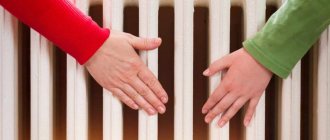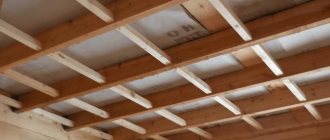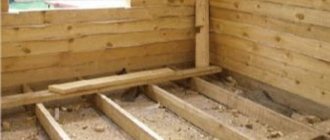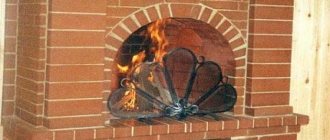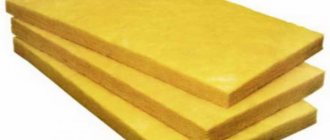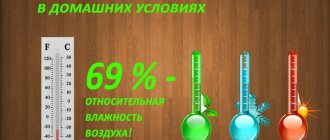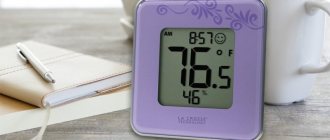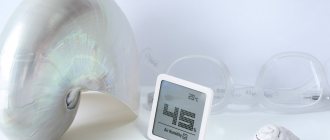The state of children's health depends not only on genetics, but also on the microclimate of the living space where the child spends most of the day. Sanitary standards provide for a comfortable temperature delta and prescribe what the humidity should be in the children's room.
Monitor the humidity in the children's room?
Yes
100%
No
0%
Voted: 3
Excessively dry air negatively affects the condition of the skin and mucous membranes of a child’s body, which leads to the development of skin diseases and reduces immunity. Dust in a dry room easily rises from the floor and other surfaces, contributing to the occurrence of allergic reactions.
Excess moisture also negatively affects the microclimate. Excessively humid air leads to the formation of mold and fungus, the spores of which cause allergies.
What is the optimal air humidity in an apartment? You can find the answer to this question in this article: //ventilation-conditioning.ru/zdorove/vlazhnost-vozdukha-v-kvartire.html
What humidity should be in a nursery?
Humidity in residential areas depends on the climate and season. In coastal regions and marshy areas, excess moisture in houses will become a problem; a ventilation system will help to cope with it. During the heating season, heating devices dry out the air. Frequent ventilation will increase the oxygen content and help get rid of excess carbon dioxide, but will cool the room.
An optimal microclimate is created by a recuperation system with humidity control, but it is very expensive to design and install; its arrangement is impossible in an apartment and not advisable in a small private house. Normal humidity levels are between 40 and 60%.
On the Internet you can find a lot of advice on how to increase air humidity, but with their help it is impossible to control its level. Hanging wet rags on radiators is a controversial decision from an aesthetic point of view, and recommendations to install a container of boiling water in the room are dangerous for people.
You can determine the humidity in a room based on your own observations. If you feel dry skin and mucous membranes, this indicates a lack of moisture. Oversaturation of air with water vapor causes a feeling of lack of oxygen.
To make a final decision on normalizing the microclimate, it is necessary to measure air humidity. Traditional methods do not provide the necessary accuracy, so it is best to use a purchased hygrometer and, based on its readings, purchase devices for air humidification.
How to increase humidity without special devices?
The amount of moisture in the air can be increased without much expense. To do this, perform the following actions:
- Place a container of water near the heating device. It is desirable that it be wide. Water must be added regularly.
- Decorate the nursery with indoor flowers. They evaporate moisture well and are indicators of humidity, as discussed above. But don’t overdo it: an abundance of flowers is undesirable, since they emit carbon dioxide at night.
- Start an aquarium that will perfectly humidify the room. It will serve both for relaxation and to create a cozy environment.
- Carry out regular ventilation. Stagnant air and a stuffy atmosphere will not add health to a child.
- Do wet cleaning twice a day. But this technique will not significantly affect the humidity, unless you clean as often as possible.
Thanks to these simple techniques, the indicator we need will increase. But control over the percentage of moisture in the air will be conditional. It is likely that this figure will not be stable. And for a newborn it should be constant.
For information: If your baby has allergies, you need to be especially careful about the humidity level. Temperature conditions, absence of dust and stagnant air are important for maintaining the health of the newborn. Otherwise, in addition to allergies, he may get asthma.
Humidifier for newborns
Temperature and humidity standards for babies are 22-25 C0 and 40-60%. When choosing a device, pay attention to the principles of its operation:
Ultrasonic
The principles of its operation are based on the supply of water to a special membrane. Ultrasonic vibrations crush the liquid, after which it mixes with air and spreads throughout the room. The devices are low-noise, capable of humidifying a fairly large room, but are demanding on water quality.
Steam
Boils and evaporates water. Suitable for installation in a cool room, because can increase not only humidity, but also air temperature. It has an aromatherapy function, consumes quite a lot of electricity, and is not recommended for installation in places accessible to children.
Traditional
The operating principle of the device is based on the natural evaporation of water. Built-in fans supply air to the wet cartridge. You can use tap water; the evaporation level is controlled by the speed of the fans.
Budget models only have a humidification function, while modern and expensive devices are equipped with the following functions:
- filtration;
- ionization;
- aromatization;
- destroying bacteria.
The most convenient devices are those with built-in humidity level sensors.
Another article about humidifiers
Sanitary standards and requirements for premises
After numerous studies, checks and confirmation of test results, which were carried out by a group of highly specialized specialists (doctors, teachers, epidemiologists, scientists), optimal temperature and humidity indicators were derived.
And the state has enshrined the mandatory observance of them in kindergartens and schools at the legislative level - SanPiN.
By maintaining a balance of food, physical and mental activity, as well as maintaining an optimal microclimate in the room, you can achieve incredible results. The child becomes active, grows well, develops
In addition, maintaining the recommended indoor regime helps strengthen the immune system; children are much less likely to get sick. And in case of illness, the immune system copes with viruses without any problems - the disease is less complicated.
Temperature and humidity in kindergarten
In the first years of their lives, it is important for children that the SanPiN standards for humidity and temperature are observed in the premises of the kindergarten. This is especially true when the seasons change, when heating and air conditioning systems begin to be actively used.
Since children engage in a variety of activities throughout the day, each room has its own temperature regime.
The child spends 8 to 10 hours a day in kindergarten for 5-6 days a week. He eats, sleeps, plays, and studies there. Therefore, it is so important that the microclimate in the garden premises corresponds to the age characteristics of the body of preschool children
In accordance with SanPiN, the air temperature in the garden should be:
- 22-24 °C - nursery groups;
- 21-23 °C - junior and senior groups;
- 19-20 °C - bedrooms;
- 22-24 °C - toilet in the nursery;
- 19-20 °C - senior group toilets;
- 22-24 °C - medical office;
- 19-20 °C - halls for active activities;
- more than 12 °C - walking veranda;
- from 29 °C - swimming pool;
- 25-26 °C - locker room and showers;
- from 15 °C - heated inter-hull passages.
This temperature difference is explained by the fact that for each type of children’s activity, the institution has a specially designed room/hall. The child sleeps in the bedroom and under a blanket - he should not be cold/hot.
Physical education classes take place in the gym, where the temperature is slightly lower than in the playroom, since the classes are active and children should not sweat during the process. In the gaming room the temperature is slightly higher than in the gym, because... Quiet activities and games also take place there.
For all nursery premises, the standards provide for a temperature higher than for older children.
To ensure the required level in gardens, regular through and corner ventilation must be carried out for 10 minutes and at least once every 1.5 hours
These recommendations are adjusted by garden workers depending on weather conditions. Children should not be in a room that is ventilated.
Humidity in kindergarten should be in the range of 40-60%. This value is regulated by ventilation:
- A short-term decrease in room temperature by 2-4 °C is considered normal;
- do not ventilate through the toilet;
- bedrooms are ventilated before daytime sleep;
- In winter, the windows are tightly closed half an hour before the children wake up.
Failure to comply with these standards can have a detrimental effect on the well-being and activity of children. As a rule, frequent colds in a group can be caused by a negligent attitude to the requirements of SanPiN by preschool employees.
The influx of fresh air in kindergarten groups helps to saturate the cells and cerebral cortex with oxygen and, as a result, improves the general condition of the child’s body. The children are cheerful, play actively, and are attentive in class.
Violation of the temperature regime and failure to maintain the required humidity provokes the following diseases in preschoolers:
- ARVI;
- growth of adenoids;
- persistent allergies and asthma;
- dermatitis.
If children in a group often get sick or there is reasonable suspicion of non-compliance with standards, parents can initiate an inspection of the kindergarten, and also contact the district education department or even the prosecutor’s office.
Temperature and humidity at school
The requirements of SanPiN 2.4.2.2821-10 are no less strict with regard to the organization of an optimal microclimate for students by a school institution.
And, although they are not focused on ranking temperature and humidity indicators by age/class, they take into account the following factors:
- The upper and lower temperature thresholds for classrooms and classrooms are 18-24 °C.
- The temperature in the halls intended for conducting classes related to vigorous physical activity is 17-20 °C.
- The minimum temperature in the pool and showers is from 25 °C.
In a school institution, it is especially important to adhere to the standards of SNIP indicators for the balance of heat and humidity. After all, within the same building every day a large number of children gather who actively consume oxygen, so it is impossible to do without regular ventilation.
Children spend part of their time in one position, which slows down blood flow and metabolism. To prevent them from freezing, it is important that it is not cold at school. And since children are simply not designed to move slowly, the rooms should not be hot
Maintaining optimal temperature throughout the entire day of classes creates favorable conditions for children’s learning activities. They are not hot during physical education classes and not cold during the 45-minute lesson in a sitting position. Such temperatures can be safely called comfortable for a child.
As a rule, the optimal air humidity in a school is the same as in a kindergarten.
To maintain it in the required parameters, regular ventilation is carried out:
- all classrooms - before and after classes;
- classrooms - during breaks;
- school corridors - while schoolchildren are in class.
The duration of each ventilation is adjusted depending on the season and the outside air temperature. A short-term decrease in temperature should not exceed 2-4 °C.
Sometimes the windows in classrooms are closed during the lesson and a large number of children - 12-30 schoolchildren - find themselves in a closed air space. This is fraught for them with loss of ability to work and decreased mental activity.
Despite the fact that the educational load for children is designed taking into account the age characteristics of their body and psyche, it is not easy for them to cope with the classes. It is especially difficult to concentrate on the lesson and perceive information with the arrival of the heating season, when there is a great contrast in temperatures indoors and outdoors. It’s too hot and stuffy in the classroom - children become lethargic, apathetic, and at low temperatures they are simply cold and not interested in studying
Therefore, even short-term ventilation during breaks is important, because the air in the classroom is enriched with oxygen. Especially in older school buildings with problematic ventilation.
Supervisory functions over the maintenance of temperature and humidity conditions in schools are carried out by local bodies of Rospotrebnadzor. Employees of this organization conduct scheduled and unscheduled inspections (in case of suspected violations, complaints) of children's institutions.
For example, if the temperature at school is not maintained, a child may faint and be seriously injured, or develop a lifelong disease such as asthma. Therefore, even suspicions that employees of a child care institution are violating the rules may be sufficient grounds for an unscheduled inspection.
If violations are detected, the following binding decisions may be made:
- An order to eliminate technical violations that negatively affect the temperature and humidity in the premises. This could be breakdowns of pipes in water supply systems, heating systems, etc.
- For negligence, workers can be punished in an amount equivalent to 100-300 minimum wages.
- Based on the act of checking and identifying violations, a criminal case may be initiated for causing moderate or severe harm to the health of a child, which is fraught with imprisonment for up to 5 years.
Parents, privately or jointly, can write a corresponding letter to Rospotrebnadzor or leave a statement/complaint/claim on the organization’s official website. You can also contact the supra-departmental authorities on the State Services website - the Ministry of Education, the regional office of the Commissioner for Children's Rights or the prosecutor's office.
Rospotrebnadzor vigilantly monitors compliance with its regulations, because their violation can not only negatively affect the health of children and employees of institutions, but cause significant harm to health
You should not be afraid of disturbing someone’s peace or of any kind of persecution towards your child from the administration of a kindergarten or school. These problems are much easier to deal with than acquired asthma or chronic ENT diseases.
Temperature and humidity conditions at home
One of the reasons for frequent morbidity in children of all ages is non-compliance with the temperature regime and critical humidity levels in the apartment. More often this is caused by parents’ ignorance of what standards need to be followed and how to check them.
Dry air causes the baby's mucous membranes to dry out, making it difficult for him to breathe. In addition, by trying to dress their beloved child warmly, parents unknowingly expose him to additional risk - he can be blown out even in the slightest draft.
Sometimes parents are simply afraid of harming their child, leaving everything as it is and sincerely wondering why the child is apathetic, eats poorly or is constantly sick.
To ensure a comfortable temperature and optimal air humidity in the apartment for a child, you can focus on the standards prescribed by SNIP.
If flowers dry out in the house, especially during the heating season, this indicates a low level of humidity in the apartment. Urgent action should be taken and raise it to at least 50%, while the norm for a child is 40-60%.
In common rooms, a comfortable temperature for a person is 21-24 °C; in a sleeping room, a lower temperature can be maintained - 19-21 °C. Then the child will sleep more soundly and breathe easier.
High humidity in bathrooms coupled with poor ventilation can cause the appearance of fungus and mold, whose spores will then be inhaled by the whole family
Temperature and humidity in the room must be balanced. Since if both indicators are high, then the microclimate in the apartment will resemble a tropical one, which is also not useful for either adults or children.
After all, such an environment promotes the reproduction and spread of pathogenic microbes and microorganisms. The ideal ratio is achieved at a temperature of 22-24 ° C and humidity - 50-60%.
Room for newborns
Since a child at birth finds himself in a new environment, the parents’ task is to help him adapt and create optimally comfortable and healthy conditions for him.
On the one hand, a newborn person is a very weak creature that needs to be protected, but on the other hand, it is unusually strong. We must not forget that his metabolism is accelerated, all body systems work in enhanced mode.
22 °C is the optimal temperature for a child’s room up to 6 months old. After six months it can be reduced to 19-21 °C. This temperature is favorable for the development of the baby.
There is no need to be afraid that your baby may be cold. He's comfortable. When you try to wrap him up, the child will try to turn around, and if he doesn’t succeed, he will sweat profusely. This can be fraught with dehydration of the baby’s body, increasing the risk of catching a cold even from a small draft.
Under no circumstances should the child be wrapped up; he will immediately become hot, he will begin to sweat, be capricious, and refuse to eat. And even if it seems that he is not moving and may freeze, this is not so - 22 ° C is a completely comfortable temperature for him
Pediatricians also recommend regularly ventilating an apartment with a newborn. Of course, this will not be the right decision at any time and not for any climate.
But if you adhere to the standards and monitor the air humidity in an apartment with a newborn, you can create a microclimate in which both adults and children will feel as comfortable as possible.
How to choose a humidifier for a nursery
If you live in an environmentally friendly place, your children do not suffer from allergies or respiratory diseases, and you can allocate a small amount to purchase a humidifier, opt for the simplest ultrasonic device that does not have additional functions.
Residents of megacities are more often susceptible to allergic reactions due to air pollution; the ecology of large cities is far from the standards, so it makes sense to choose a device equipped with cleaning and ionization functions. There is no point in installing a fragrance cleaner in the children's room; some odors can cause allergic reactions.
All other things being equal, give preference to a device that:
- with a compact size, it has a spacious tank;
- equipped with a clear control system;
- has a noise level of no higher than 40 dB.
Pay attention to the estimated area of the room, the level of energy consumption and the frequency of filter changes.
Temperature in the room for a newborn Choosing clothes depending on the room temperature
Added 05/2017
Fragment of translation of advice for parents on caring for babies published by the American Academy of Pediatrics (publication dated 2015):
- In cool temperatures (below 23.88 degrees Celsius): baby needs several layers of clothing to stay warm. As a general rule, it is best to dress your baby in a onesie and diaper, put on a onesie/pyjamas on top, and then wrap him in a blanket. You can also use a special sleeping bag as a blanket.
- In hot temperatures (above 23.88 degrees Celsius): You can reduce the amount of clothing by one layer. It is also recommended to use the rule: dress your child one layer warmer than yourself.
Source here (eng).
From this publication we can conclude that official medicine considers the optimal temperature for a child from 1 to 3 years old who is at home in single-layer clothing to be 23.88 degrees Celsius.
Where to put a humidifier in a children's room
The main criteria for choosing a place to install a humidifier in a nursery are safety and efficiency:
- position the device so that the child cannot reach it;
- install the humidifier at a height of at least half a meter from the floor;
- place it as close as possible to the heating device, this will allow you to achieve optimal humidity.
Attention! A silent humidifier will not disturb sleep, which is especially important for children with increased excitability and hyperactivity.
Monitor the water level in the device. Modern humidifiers are equipped with a shutdown function when there is no water, so adding it in a timely manner will ensure uninterrupted operation of the device.
Excess moisture is just as harmful as its lack; check the humidity level with a hygrometer, or use a humidifier with the function of automatically measuring this parameter.
Komarovsky's opinion
What this famous doctor thinks is of interest to many parents, because his advice is not only reasonable, but also useful. Komarovsky associates the increase in morbidity rates in the cold season with dry air. After all, heating devices often actually dry it out. The nose contains villi that trap viruses and pathogenic microorganisms and prevent further penetration. And since the air is too dry, the nasal mucosa dries out, and the villi in this case are not able to fulfill their purpose. Then viruses and infections easily enter the body, and as a result the child gets sick.
Regarding the norm of air humidity in an apartment for a child, Komarovsky adheres to the opinion of the majority of doctors. This is especially important for a sick child, because it is much easier to transform a dry cough into a productive one in high humidity. If it is not possible to raise it, it is recommended to give the child something to drink more often and rinse the nose with saline solution.
Why do you need a humidifier in a nursery?
A good humidifier can maintain a comfortable microclimate and clean the room from dust and bacteria. Children have weaker immunity compared to adults. During active games, the smallest particles of dust along with bacteria rise to the top.
The drier the air, the more dust is scattered in it. Children's short stature and their habit of playing on the floor increase the risk of inhaling polluted air. Using a humidifier reduces dust levels and reduces the incidence of viral and respiratory diseases.
Why is it important to monitor humidity?
Have you heard the expression that a person is 80% water? For adults, this figure is, of course, exaggerated, but for newborns it is even underestimated. If the air in the room is dry, the baby will constantly lose moisture through breathing and through the skin. Fluid loss will be especially intense in a hot room. The mucous membranes of the eyes and nose will dry out, which means the natural barrier to viruses and bacteria will disappear.
It is important!
Insufficient air humidity is a hidden cause of frequent ARVI in children.
The first step in the treatment of colds, rhinitis, and otitis should be to bring it to normal values. Dried mucus in the nose turns into crusts. They prevent air from passing freely: it will be difficult for the baby to breathe through his nose and difficult to eat. He will become capricious and refuse to breastfeed. Dry skin also becomes vulnerable. Pathogenic bacteria easily penetrate through microdamages. Redness, peeling, and irritation may occur on the skin. Too humid air is also harmful. This is an excellent environment for pathogenic microorganisms, that is, again the cause of childhood diseases.
Danger of low humidity levels
Low moisture content in room air negatively affects the well-being of all newborn babies. Parents often do not notice reduced levels of this parameter, but the child reacts sharply to any discomfort.
A reduced level of moisture in the room leads to sharp dust in the air, an increase in the number of pathogens and allergens. Most often, the results of dehydration are various negative conditions:
- Asthma. When the body becomes dehydrated, areas of the lungs can be damaged, resulting in chronic inflammation of the respiratory system.
- Allergic diseases. If there is a lack of moisture in the body, the level of histamines in the circulatory system increases. An allergy occurs, which can manifest itself as a rash, rhinitis, and itching sensations.
- Dry skin. Dehydration damages the upper layers of the skin, resulting in dry patches on the child's body.
- Dry mouth and nose. Low humidity causes the airways to dry out. Dry crusts form in the nasal cavity, and the child begins to cough.
- Blood thickening. The volume of fluid decreases, the blood begins to thicken, which is extremely dangerous for the entire child’s body.
Thus, it is extremely important for an infant to be in a room with an optimal level of humidity. This is not just a whim, but the most important condition for normal child development
Be sure to remember this!
Temperature in the room for a newborn Arguments of supporters of the COOL mode
According to many experts, in hot weather the likelihood of getting sick is much higher than in moderate temperatures or even cold. In this regard, many modern experts recommend 18-20°C for the constant stay of children. They justify their position by the fact that heat is a favorable environment for the development of viruses. At the same time, when overheated, the body directs all resources to cooling. Thus, while the body is busy with issues of thermoregulation, viruses have every chance of growing to the scale of a disease. The arguments are quite convincing, but I want to ask, “Why do people get sick less in the summer?” ? .
Recently, the recommendations of the well-known Doctor Komarovsky have become increasingly popular, who recommends maintaining 18-19° in the nursery for newborns
At the same time, he emphasizes that 18-19° is comfortable air for breathing, but not for a child to remain without clothes. It remains a mystery how, with such coolness in the nursery, one can carry out countless changes of clothes for the baby, as well as resting “with a bare bottom” from the diaper
In my opinion, this recommendation is divorced from life.
The pioneer in recommending lower temperatures for children was I.A. Arshavsky. In his works, he developed the theory of using the adaptive mechanisms of newborns to strengthen the immune system using early hardening methods. In fact, the extent to which hardening is necessary for a newborn is a controversial issue, so before considering its feasibility, I propose to study the opinions of supporters of a comfortable temperature regime.
Dry air danger
Dry air in an apartment has an extremely negative effect on infants and forces the body to use additional resources. The level of humidity in a room is influenced by certain factors:
- change of season;
- change in weather conditions;
- building materials used to decorate the premises and façade of the building;
- air conditioning and heating systems.
Due to the increased temperature in the room, the child loses a large amount of moisture due to sweating, and the need to humidify the inhaled oxygen contributes to an even greater loss of residual fluid resources. The hot season and dry rooms are fraught with the following consequences for the baby:
- sleep problems;
- increased gas formation;
- capriciousness;
- dysbacteriosis;
- diseases of the genitourinary system.

